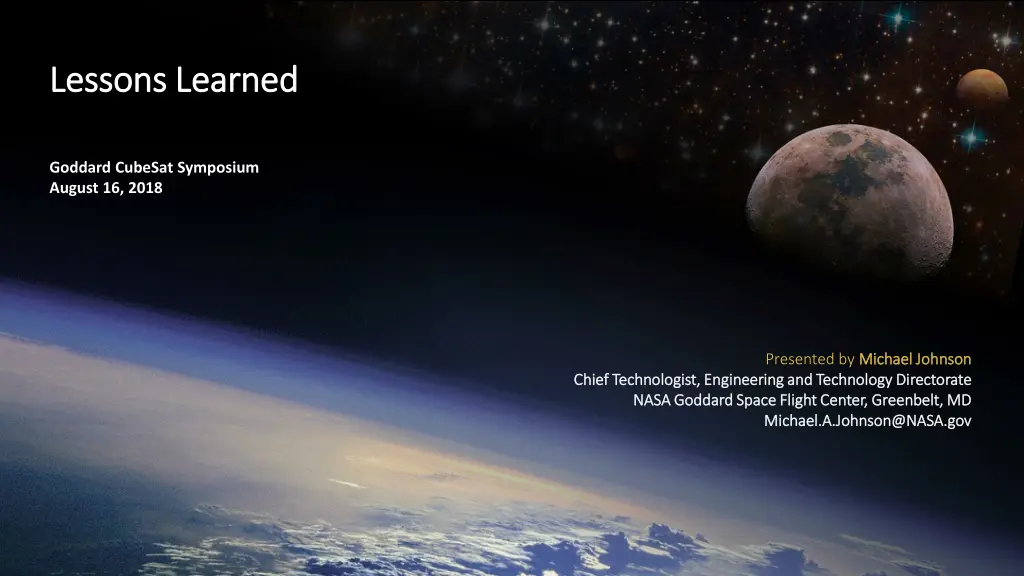
Lessons Learned from NASA Goddard CubeSat Symposium
Explore valuable insights on maturing the platform and engineering the system from the NASA Goddard CubeSat Symposium presented by Michael Johnson, Chief Technologist at NASA Goddard Space Flight Center. Discover the importance of intentional effort in addressing challenges and the significance of resilient design in CubeSat missions.
Download Presentation

Please find below an Image/Link to download the presentation.
The content on the website is provided AS IS for your information and personal use only. It may not be sold, licensed, or shared on other websites without obtaining consent from the author. If you encounter any issues during the download, it is possible that the publisher has removed the file from their server.
You are allowed to download the files provided on this website for personal or commercial use, subject to the condition that they are used lawfully. All files are the property of their respective owners.
The content on the website is provided AS IS for your information and personal use only. It may not be sold, licensed, or shared on other websites without obtaining consent from the author.
E N D
Presentation Transcript
Lessons Learned Lessons Learned Goddard CubeSat Symposium August 16, 2018 Presented by Michael Johnson Michael Johnson Chief Technologist, Engineering and Technology Directorate Chief Technologist, Engineering and Technology Directorate NASA Goddard Space Flight Center, Greenbelt, MD NASA Goddard Space Flight Center, Greenbelt, MD Michael.A.Johnson@NASA.gov Michael.A.Johnson@NASA.gov
Lessons Learned Discussion Points Lessons Learned Discussion Points 1. Maturing the Platform 2. Engineering the System 3. The Who 2 2
Lessons Learned Maturing the Platform Planetary CubeSats by traditional standards is an oxymoron Planetary CubeSats by traditional standards is an oxymoron 3 3
Lessons Learned Maturing the Platform Planetary CubeSats by traditional standards is an oxymoron Planetary CubeSats by traditional standards is an oxymoron Ref. M. Swartwout Ref. M. Swartwout 4 4
Lessons Learned Maturing the Platform Planetary CubeSats by traditional standards is an oxymoron Intentional effort is required to address Intentional effort is required to address this inconsistency this inconsistency Ref. M. Swartwout Ref. M. Swartwout 5 5
Lessons Learned Engineering the System Engineering the System is just as important as Systems Engineering Resilient/ robust design must be intentional 6 6
Lessons Learned Engineering the System Application of appropriate systems and processes is essential Expertise with big iron is not always helpful 7 7
Lessons Learned Engineering the System Don t trust. Verify. Effective collaborations can change this current reality 8 8
Lessons Learned Engineering the System Good software is critically important 9 9
Lessons Learned Engineering the System The mission system is not just in space Cognizance of the space and ground segments as a unit should inform mission design 10 10
Lessons Learned The Who Effective science-engineering collaboration can markedly enhance the mission 11 11
Lessons Learned The Who A focused and stable team will greatly enhance mission confidence Pass down historical knowledge Increase cost/schedule efficiency 12 12
Lessons Learned The Who Recover the art of sound thinking 13 13
Lessons Learned A Closing Thought Deployment of planetary CubeSats will expand the possible. 14 14
Lessons Learned A Closing Thought Deployment of planetary CubeSats will expand the possible. But a little knowledge can be worse than none at all. 15 15
Lessons Learned A Closing Thought Deployment of planetary CubeSats will expand the possible. But a little knowledge can be worse than none at all. Effective collaboration and knowledge sharing can address this challenge. 16 16
Thank you. Imagination is more important than knowledge. Albert Einstein Michael.A.Johnson@NASA.gov 17





